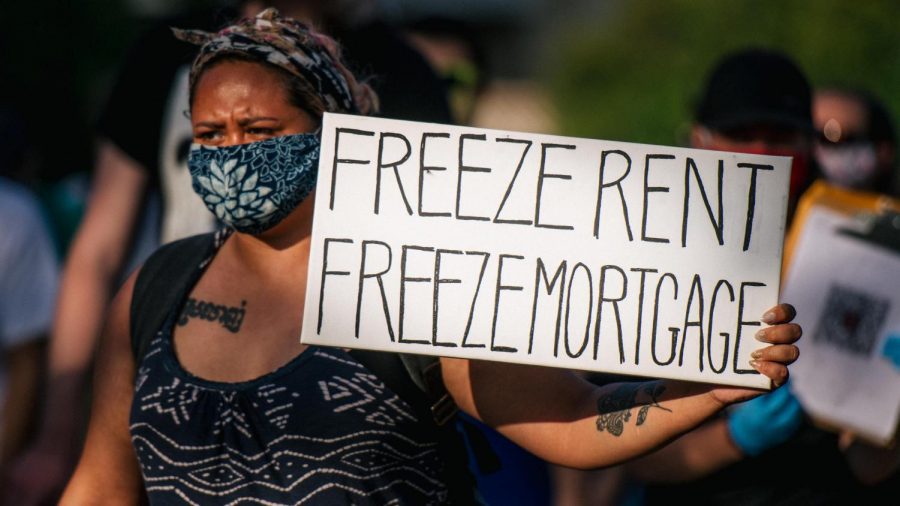Mass Eviction and Desperation in the United States
A protester calls for the government to halt payment on rent and mortgage during a demonstration in Minneapolis. BRANDON BELL / GETTY IMAGES
November 20, 2020
Right now, the United States is confronting what is quite possibly the worst housing crisis we’ve ever seen. The Covid-19 Pandemic and the subsequent market crash have caused sweeping job losses across the country since March and April, and though some are starting to return to work, many are still struggling to get back on their feet. The cohort of workers who make twenty-seven thousand dollars a year or lower are taking the hardest hit, as they are also the ones most likely to be renting homes. As a result, many lower-wage workers have started to lose their homes.
This didn’t just start happening because of the economic downturn, however. Even before the virus hit, the US’s eviction rate was much higher than most other countries. The week before the pandemic struck in March, 21 million renter households (almost half) were already rental cost-burdened. This means that the renters were devoting at least 30% of their income to paying rent. About 25% of renters were spending over half of their income, and 1 in 4 renters below the poverty line were spending over 70% on housing (Aspen Institute). Also, about 1 in 40 renters had already been evicted by the second week in March. When compared to France, where 1 in 25,000 has been evicted, the disparity is astounding.
We were already in the midst of a major housing crisis, the pandemic only accentuated it further. During the first few weeks in March and April, when millions of people were being laid off, the government supported them by adding more money to the unemployment checks. The money wasn’t a lot, but it allowed most renters to pay their rent and keep their place of residence, while trying to find a job. However, those extra payments were suddenly cut off in July, leaving renters with no money, and no other choice but to vacate their homes.
All the while, Democrats in Congress pushed to pass a relief bill that would halt evictions and protect renters, but House and Senate Republicans stood firm against it. Eventually, amid pressure and a falling approval rating, President Trump issued a temporary halt to all evictions through the Centers for Disease Control. However, this amnesty is incredibly difficult to access.
First, landlords are not required to notify the renters, who can still be evicted if they are unaware. Second, there are numerous vague requirements that are subject to the judge’s personal opinion at the eviction hearing, which makes qualification for this halt in evictions even more difficult. Among them are the following:
- “I have used best efforts to obtain all available government assistance for rent or housing;
- I either expect to earn no more than $99,000 in annual income for Calendar Year 2020 (or no more than $198,000 if filing a joint tax return), was not required to report any income in 2019 to the U.S. Internal Revenue Service, or received an Economic Impact Payment (stimulus check) pursuant to Section 2201 of the CARES Act;
- I am unable to pay my full rent or make a full housing payment due to substantial loss of household income, loss of compensable hours of work or wages, lay-offs, or extraordinary out-of-pocket medical expenses;
- I am using best efforts to make timely partial payments that are as close to the full payment as the individual’s circumstances may permit, taking into account other nondiscretionary expenses;”
These agreements allow the government to decide whether or not a tenant qualifies, by using terms like “best efforts” and “unable” which are purely subjective. However, these are not the only statements in the form that may qualify or disqualify you. Another condition hidden in the form: “You are still required to pay rent and follow all the other terms of your lease and rules of the place where you live. You may also still be evicted for reasons other than not paying rent or making a housing payment. This declaration is sworn testimony, meaning that you can be prosecuted, go to jail, or pay a fine if you lie, mislead, or omit important information.”
If you or someone you know is at risk of eviction due to the Covid-19 Pandemic, look up CDC Eviction Form on Google, click on the Declaration pdf, and read it through to see if you qualify. You can also find it at this link: https://www.cdc.gov/coronavirus/2019-ncov/downloads/declaration-form.pdf. Then, a physical copy will need to be presented to the landlord, or to the court if a hearing has already been scheduled. They will not ask for it, so you will need to be vocal and let them know that you have the CDC Eviction Form. It can be accessed on the school computers and printed out in either the school library or at one of the public libraries. Hours of access vary, so make sure to check beforehand at https://www.boisepubliclibrary.org/programs-services/ to find the hours of the location nearest to you. Make sure you have filled it out completely and truthfully. Although it seems like a long-shot at success, this may be the only other option, and it could provide at least a small bit of stability while we start to regain normalcy.



